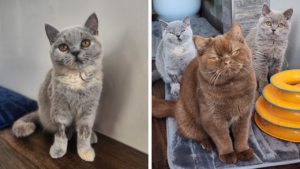On National FIP Awareness, Research, and Education Day, we at Family Friends Veterinary Hospital want to take the opportunity to shed light on feline infectious peritonitis (FIP), a challenging and often devastating disease in cats. This day is dedicated to increasing awareness about FIP, supporting research, and educating pet owners about the importance of early diagnosis and potential treatments. As we learn more about FIP, we also grow closer to new treatments that offer hope for cats and their owners.
What is Feline Infectious Peritonitis?
Feline infectious peritonitis is a serious viral disease caused by a mutation of the feline coronavirus (FCoV). Unlike the highly contagious COVID-19, FCoV is relatively common in cats and typically causes only mild gastrointestinal symptoms, if any at all. However, in rare cases, this virus mutates, leading to FIP—a life-threatening condition that triggers an extreme immune response in the affected cat.
There are two main forms of FIP:
- Wet (effusive) FIP: Characterized by the accumulation of fluid in the abdomen or chest, leading to difficulty breathing and visible abdominal swelling.
- Dry (non-effusive) FIP: Lacks fluid accumulation and instead presents symptoms like fever, weight loss, organ failure, and neurological signs.
Both forms of FIP are challenging to diagnose and treat, and unfortunately, the disease is often fatal. However, advances in veterinary science have brought about promising developments in FIP research, giving new hope to cat owners and veterinary professionals alike.
The Mystery Behind FIP: Why Does it Happen?
FIP develops due to a mutation of the common feline coronavirus, but not all cats exposed to this virus will develop the disease. Factors such as age, genetics, and stress seem to play a role in determining which cats are at greater risk.
FIP is more common in young cats under two years old and older cats with weakened immune systems. Additionally, environments with large numbers of cats, like shelters, increase the likelihood of exposure to feline coronavirus, heightening the risk of FIP development in these settings.
Understanding the complexities of FIP requires further research. By gaining insight into the environmental, genetic, and immunological factors associated with FIP, researchers can make strides toward finding effective treatments and preventive measures.
Recognizing the Symptoms of FIP
Since FIP can mimic other diseases, it can be difficult to diagnose in its early stages. If you notice any of the following symptoms in your cat, contact us at Family Friends Veterinary Hospital as soon as possible:
- Persistent fever not responding to antibiotics
- Weight loss and loss of appetite
- Lethargy and reluctance to play or move
- Breathing difficulties (in wet FIP)
- Neurological symptoms, such as seizures or head tilting
Early intervention can make a significant difference in the quality of life for a cat with FIP, and it is essential to bring your cat in for a checkup if you observe any unusual symptoms.
Diagnosis and Treatment: Advances in FIP Research
Historically, diagnosing FIP was a challenging and often inconclusive process. Traditional diagnostic methods, such as blood tests, often lack the specificity needed to confirm FIP. Today, advancements in polymerase chain reaction (PCR) testing and immunohistochemistry have improved our ability to detect FIP-specific mutations, allowing veterinarians to diagnose the disease with more accuracy.
Treatment has also seen groundbreaking developments. In recent years, antiviral drugs like GS-441524 have shown promise in clinical trials, with many cats responding positively to treatment. Although these drugs are not yet FDA-approved, they represent a major step forward in FIP research and have saved the lives of many FIP-affected cats worldwide.
In addition, ongoing studies continue to investigate other treatments and potential vaccines. These efforts rely on the support of veterinary organizations, research institutions, and compassionate cat owners who contribute to FIP-focused charities and awareness campaigns.
Supporting FIP Research: How You Can Help
Supporting FIP research can make a direct impact on the lives of cats affected by this disease. Here are a few ways to get involved:
- Donate to FIP-Specific Charities: Several organizations, such as the SOCK FIP (Save Our Cats and Kittens from Feline Infectious Peritonitis) and the Morris Animal Foundation, are dedicated to funding FIP research. Every donation helps advance the science behind understanding and treating this disease.
- Raise Awareness: Sharing information about FIP with fellow cat owners can make a difference. Through awareness, we can help other pet owners understand the symptoms and seek early intervention.
- Advocate for Research Support: Encouraging veterinary institutions and researchers to prioritize FIP studies is crucial for the development of effective treatments and vaccines.
- Join or Support Cat Rescue Organizations: Shelters and rescue organizations play an essential role in protecting vulnerable cats from FIP. By supporting them, you help reduce the incidence of feline coronavirus in high-risk environments.

Left: Tansy, a British Shorthair. Right: Tansy (on the right) along with her two fur siblings, also British Shorthairs.
Tanzy’s Journey with FIP: A Story of Resilience and Hope
FIP is an incredibly challenging disease, and unfortunately, young cats like Tanzy, a 5-month-old British Shorthair, can be especially vulnerable. Tanzy had recently moved into her new home when her family noticed she wasn’t quite herself. The excitement and change of a new environment were likely overwhelming, creating stress that weakened her immune system. Before long, what seemed like a common gastrointestinal bug revealed itself as something more serious.
FIP develops when the enteric (gastrointestinal) coronavirus mutates in a cat’s body, but not all cats exposed to this common virus will develop the disease. In fact, coronavirus is highly prevalent in group living situations like breeders, shelters, and rescues, with an exposure rate between 80-100%. However, only a small percentage—around 5%—of these cats experience the mutation that leads to FIP. There’s no solid answer yet as to why an unlucky few cats develop this mutation, although researchers believe factors like genetics, immune health, and stress may play a role.
Despite FIP’s connection to coronavirus, it’s important to note that FIP itself is not contagious. Tanzy’s case illustrates how quickly and unpredictably FIP can emerge, even from an initial viral exposure that seemed mild.
Navigating FIP Treatment Options
Tanzy’s family faced difficult choices, as FIP treatments remain limited and challenging to access. Although antiviral medications have shown great promise, helping about 90% of cats treated daily for the full 12-week course to recover, these drugs are not yet FDA-approved. While the FDA has allowed compounding pharmacies to produce these drugs and veterinarians to prescribe them for specific FIP cases, the costs remain significant. Treating a cat like Tanzy can range from $1,000 to $3,000, depending on the size of the cat and the amount of medication needed, not including follow-up visits and bloodwork.
For cats like Tanzy, early diagnosis and prompt treatment are crucial for the best chances of recovery. Thankfully, her family was able to act quickly, giving her a fighting chance against this often-fatal disease.
A Message of Hope for Tanzy and FIP-Affected Cats
While FIP remains a serious diagnosis, stories like Tanzy’s remind us of the hope that new treatments bring. The advancements in FIP care have saved countless lives, offering a 90% success rate with dedicated daily treatment and ongoing monitoring. Tanzy’s resilience serves as an inspiring example for other families facing FIP, highlighting the importance of early diagnosis, proactive treatment, and the loving support of families committed to seeing their pets through.
At Family Friends Veterinary Hospital, we’re here to support pet owners navigating FIP and other challenging diagnoses. If you have questions about FIP or need guidance on how to support your cat’s health, please reach out. We’re dedicated to offering resources, treatment options, and compassionate care for families like Tanzy’s who are bravely taking on this journey.







